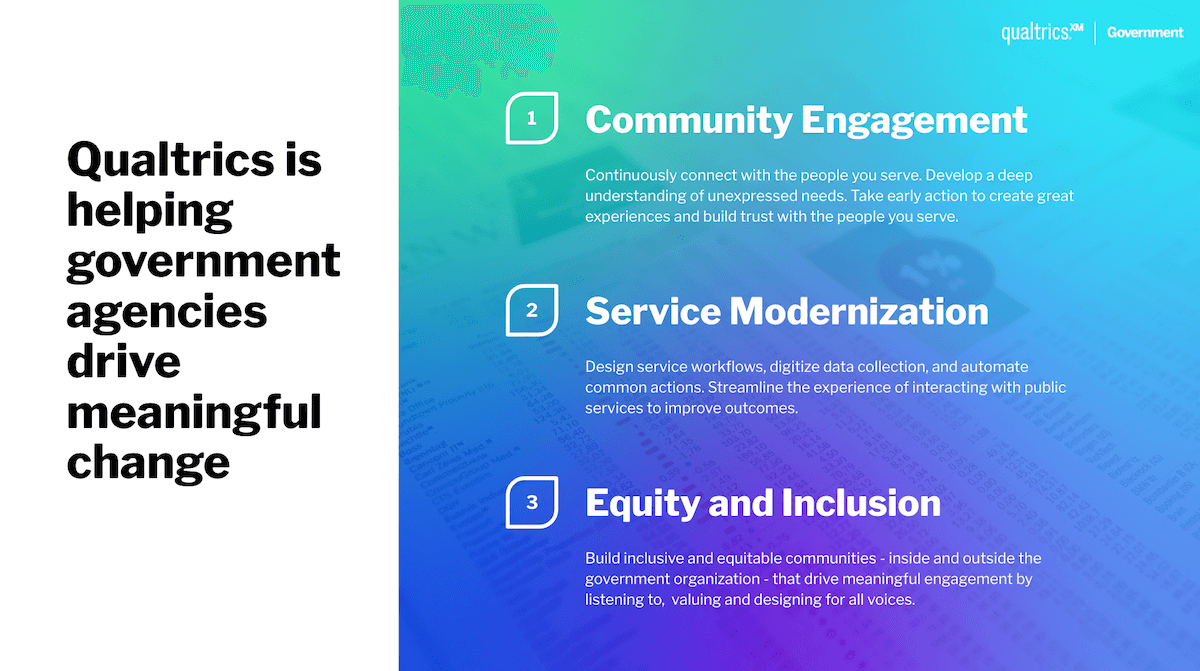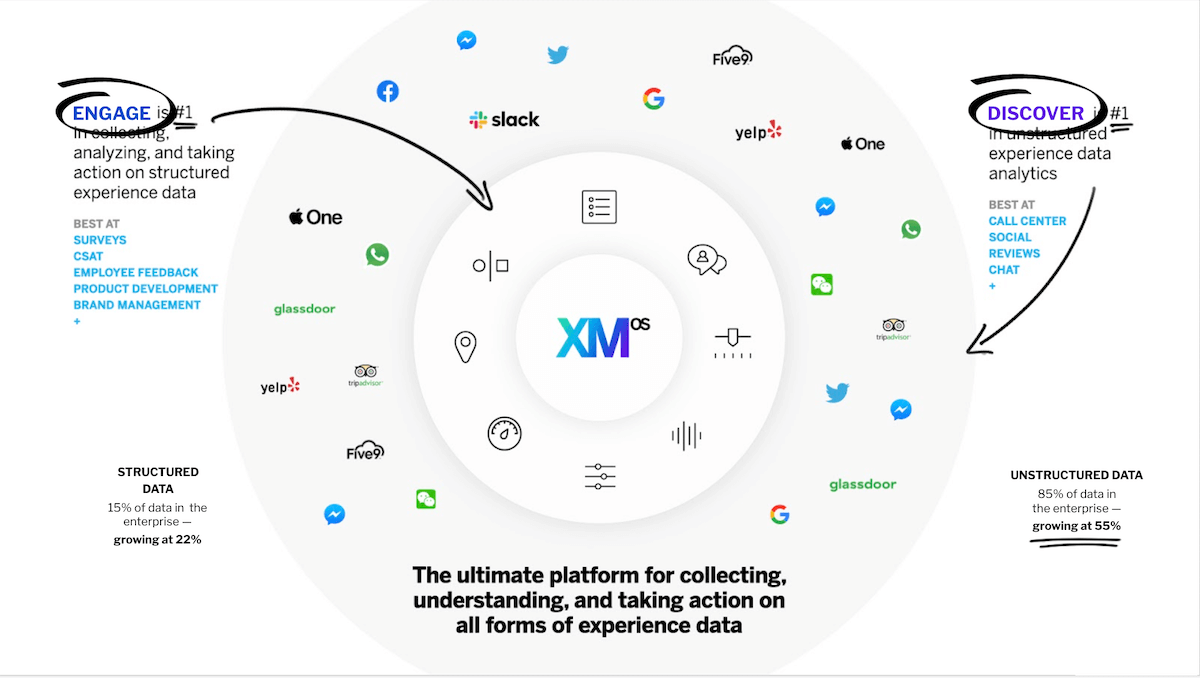What is community engagement?
Community engagement is a common research focus in government that seeks to understand and act on community members’ values, concerns, and aspirations. Used for a proactive approach to government, a community engagement strategy ensures the ideas of community members are prioritised and utilised to drive intentional governmental services and systems development, while simultaneously building trust.
For government leaders, an effective community engagement strategy requires a shift from historic siloed organisational thinking to broader community-focused thinking. This shift is predicated on the solicitation of constituent input through both structured and unstructured, strategic engagements, such as:
- Online communities
- Social media platforms
- Mandatory community public comment activities
These touchpoints foster engaging conversations that are critical to the development of project ideas that are supported by and have the buy-in of local community stakeholders – ultimately leaving community members feeling heard and empowered.

Why is community engagement important?
The consequences of not deploying effective community engagement strategies are costly. It can help avoid reworking projects the public is unhappy with or launching services that are not relevant to a community.
Without engaging local communities to understand their experiences, government organisations deepen the divide between government and community which fosters distrust. Additionally, this lack of strategy leaves historically underrepresented communities and their members further segregated from conversations that directly involve and impact them.
Whereas agencies who deploy an intentional community engagement strategy can discern the right channels to engage communities and effectively deliver support to people when it matters most.
Community engagement in practice
Take the COVID-19 pandemic as an example. Agencies with well-structured community engagement processes would have had a baseline understanding of their community demographics, how to best communicate with and provide service to different segments of their community, and therefore would have designed critical programs such as testing and vaccination services accordingly. They could pulse the community to see how communication and accessibility shifted during the pandemic too. For example, would those who typically rely on public transportation to obtain government services still have access to it, or even be comfortable on a bus or subway in the height of the pandemic?
Community engagement helps government policy and decision-makers understand the diverse intersections and lived experiences of their communities, and deliver community projects and engagement plans that close community experience gaps. It recognises that the makeup of a community, as well as its needs and preferences, change over time. Understanding this means getting it right the first time.
Common Challenges in Executing a Community Engagement Strategy
So why isn’t every government agency operating with a community engagement strategy?
For many agencies, resources are an ongoing issue. Organisations doing community engagement effectively often don’t have research expertise or significant hours to devote to analysing feedback. They have the right tools, templates, and automation to help them.
Having the tools to understand how life manifests for each unique member in the location they live, learn, work, worship, and play is vital for closing equity gaps and creating sustainable and vibrant communities.
How to drive impactful community engagement strategies
To make meaningful progress, community managers at the local, state, and federal levels need to strive to maintain a set of agile, proactive community engagement strategies, predicated on continuous real-time community feedback.
Increased utilisation of robust digital intelligence tools can aid governments in identifying the actual needs of the community and comparing them to the community’s perception of how those needs are currently being met.
This intersectional understanding is essential to earning both short-term and long-term community trust that is critical to future strategic community engagement and development.
While a number of governments practice community engagement regularly, getting quality feedback is an enormous challenge. Many governments have struggled to:
- Receive a significant number of responses from community members
- Get responses from a true representative sample of residents
- Collect the right data at the right time to elicit an effective response from community members.
We can help to mitigate these barriers through a proven community engagement model that agencies can plug into, based on where their current community engagement strategy falls.
- Outreach: Provide the public with balanced and objective information.
- Consultation: Obtain feedback analysis, alternatives, and decision
- Involvement: Work with the public to ensure that concerns are consistently understood and considered.
- Collaboration: Partner with the public to identify the preferred solution and develop alternatives
- Empower: Engage the public in the final decision-making process

4 ways to engage communities and build trust
1. Focus Groups
Focus groups are a quick, simple way to engage people in their community engagement strategy, The group interviewing technique uses conversations between target community audiences to generate community feedback data. Focus groups provide a distinct and insightful community perspective, as the process draws on the knowledge and experiences of members, and can be used to explore why and how community members feel and think in a particular way.
2. Community Meetings
A community meeting offers a means to exchange ideas and information. They are a great method for bringing together a cross-section of viewpoints. This method allows members to be actively involved in key conversations and aids in building trust in government, given the transparent nature of the process.
3. Online Digital Engagement
Online digital engagement, as a part of a broader community engagement strategy, is a useful way to reach and engage with various stakeholders. This may take place via any combination of social media, web online community discussion platforms, and so on.
Digital community engagement has been shown to increase community members’ understanding of critical community matters and fosters support for ongoing projects and programs. Both governments and community members benefit from this method, as the ability to engage hard-to-reach community members via their online community is significantly magnified.
4. Surveys
Surveys are a great tool to hear from target populations. The information gathered from a survey is ideal for measuring changes to needs in a particular target community over time. Here are a few tactical design tips:
- Use conversational language to avoid formal, bureaucratic lingo
- Include an introductory paragraph that explains the survey purpose, who is collecting data, and how the data will be used
- Limit the number of required questions that might prompt a respondent to abandon the survey
- Limit open-ended questions that take more effort for respondents to answer
- Include pictures and graphics to increase engagement and agency branding to increase trust
- Use auto-advance features to move respondents through surveys automatically
Learn about Qualtrics’ Community Pulse solution with an off-the-shelf community engagement survey and dashboard built just for government
The key to modernising your community engagement strategies
More often than not, key community feedback is scattered and trapped within various repositories across multiple departments. This decentralised nightmare only serves to provide a fragmented view of community needs and lacks an actionable approach to problems. It’s the same old broken love story of isolation.
Imagine an intuitive system that has the distinct ability to take all current cross-functional data, analyse it within one system, and give crystal clear direction on what action will have the most impact. All this is based on real data and insights from a target audience.
The Qualtrics XM platform’s world-class technology provides one system of record, one source of truth to allow government agencies the ability to actively and continuously listen to community members to gain critical, powerful insights into the community’s opinions, thoughts, feelings, and emotions.
Whether you want to understand every touchpoint between residents and your agency, or simply stand up for a community engagement solution, Qualtrics can meet you where you are.

See experience management for government in-action.